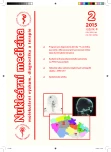-
Medical journals
- Career
Radiation protection of medical staff on PET/CT departments
Authors: Renáta Kohutová 1,2; Vítězslav Jiřík 2; Vojtěch Ullmann 3
Authors‘ workplace: Oddělení nukleární medicíny, PET/CT, Nemocnice Nový Jičín, a. s. 1; Ústav epidemiologie a ochrany veřejného zdraví, LF Ostravské univerzity, Ostrava 2; Klinika nukleární medicíny, LF Ostravské univerzity a Fakultní nemocnice Ostrava 3
Published in: NuklMed 2015;4:28-33
Category: Review Article
Overview
The article gives an overview on elaborated problems of the radiation protection of staff at the nuclear medicine department. In the introduction, there is presented the current number of PET scanners in the Czech Republic as well as geographically processed data on the total number of PET examinations at the workplaces of our country from 1999 to the 2014. In addition to the already eight existing institues there are another six new PET/CT scanners approved in the Czech Republic. The level of radiation protection at work when applied open radionuclide sources was already detected in abroad in many studies. In Poland they examined the influence of IR on DNA. In Ireland, they measured the dose to the eye lens by special dosimeter in order to compare the readings with the value of newly proposed limit for the eye lens of 20 mSv. In Spain they assessed various workflows and also other countries conducted optimization based on the studies. In the Czech Republic we held a retrospective study, especially in workplaces where there are beds for 131I therapy and there was an increase in processed annual activity, for example at 99mTc. ORAMED project, which took place within 32 European countries and was aimed at radionuklides 99mTc, 90Y and 18F. The result of the measurement of the exposed skin on hands at various locations was the recommendation to change the position of the finger dosimeter and to use a correction factor to calculate the dose on the skin of hand. It was found that the highest dose was measured at the tip of the index finger, while the finger dosimeter is worn at the base of the II., III. or IV. finger of more used hand. According to the recommendations, the calculation of the dose with using correction factor would come out from the measurements at the base index finger. This project also results in work that is focused on local irradiation of skin on workers’ hands at the departments of nuclear medicine in the country.
Key Words:
PET/CT, radiation protection
Sources
1. Ullmann V, Jaderná fyzika a fyzika ionizujícího záření. [online]. [cit. 2015-04-25]. Dostupné na: http://astronuklfyzika.cz/Fyzika-NuklMed.htm
2. Kolektiv autorů. Ochrana při práci se ZIZ. In Sborník učebních textů. Ostrava, DTO CZ s.r.o, 2010, 248 p
3. Vyhláška č. 307/2002 Sb. O radiační ochraně [online]. 2002. [cit. 2015-04-25].Dostupné na: https://portal.gov.cz/app/zakony/zakon.jsp?page=0&nr=307~2F2002&rpp=15#seznam
4. Dobrzyńska MM, Pachocki K A, Gajowik A et al. The Effect Occupational Exposure to Ionizing Radiation on the DNA Damage in Peripheral Blood Leukocytes of Nuclear Medicine Personnel. J Occup Health 2014;56 : 379–386
5. Walsh C, O‘Connor U, O‘Reilly G. Eye dose monitoring of PET/CT workers. Br J Radiol. 2014;87(1042):20140373
6. Vargas Castrillón S, Cutanda Henríquez F. A study on occupational exposure in a PET/CT facility. Radiat Prot Dosimetry.2011;147 : 247-249
7. Antic V, Ciraj-Bjelac O, Stankovic J, et al. Radiation exposure to nuclear medicine staff involved in PET/CT practice in Serbia. Radiat Prot Dosimetry. 2014;162 : 577-585
8. Covens P, Berus D, Vanhavere F et al. The introduction of automated dispensing and injection during PET procedures: a step in the optimisation of extremity doses and whole-body doses of nuclear medicine staf., Radiat Prot Dosimetry. 2010;140 : 250-258
9. Sans Merce M, Ruiz N, Barth I et al. Extremity exposure in nuclear medicine: preliminary results of a European study. Radiat Prot Dosimetry. 2011;144 : 515-520
10. Watanabe H, Satou T, Senzui N et al. National Survey of Radiation Protection for Workers in Positron Emission Tomography. Facilities in Japan−1st Report: Occupational Role Assignment, Radiation Exposure to Medical Workers. Japanese Journal of Radiological Technology. 2009;65 : 285-294
11. Hušák V, Ptáček J, Drymlová J et al. Radiační zátěž rukou pracovníků v nukleární medicíně připravujících radiofarmaka se zářiči gama včetně pozitronového zářiče 18F. Ces Radiol 2007;61 : 80–84
12. Doležal J. Stanovení kvality radiační ochrany a efektivních dávek pracovníků na oddělení nukleární medicíny ve FN Hradec Králové v letech 2000-2007. Ces Radiol 2009;63 : 99–102
13. Hudzietzová J, Prchalová D, Sabol J et al. Radiační zátěž pracovníků na klinice nukleární medicíny a endokrinologie 2. LF UK a FN v Motole v letech 2006-2011. Ces Radiol 2013; 67 : 87–94
14. Hudzietzová J, Koláček M, Ullmannová L et al. Zhodnocení průměrné roční efektivní dávky a průměrné roční ekvivalentní dávky na ruce u personálu Kliniky nukleární medicíny Fakultní nemocnice Ostrava v letech 2006–2012. Ces Radiol 2013; 67 : 225–231
15. Hudzietzová J, Fülöp M, Sabol J et al. Radiační zátěž rukou pracovníků během přípravy a aplikace radiofarmak značených radionuklidem 18F. Ces Radiol 2014;68 : 318–322
Labels
Nuclear medicine Radiodiagnostics Radiotherapy
Article was published inNuclear Medicine

2015 Issue 2
Most read in this issue- Incidental detection of tumor duplicity on bone scan – SPECT/CT
- Radiation protection of medical staff on PET/CT departments
- Software „ActivityDetermination“ for determination of activity of 131I for treatment of patients with differentiated thyroid cancer
Login#ADS_BOTTOM_SCRIPTS#Forgotten passwordEnter the email address that you registered with. We will send you instructions on how to set a new password.
- Career

